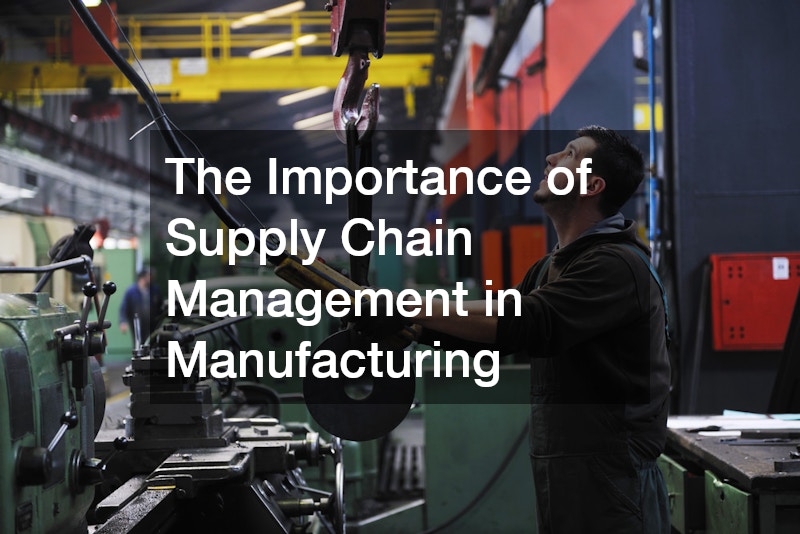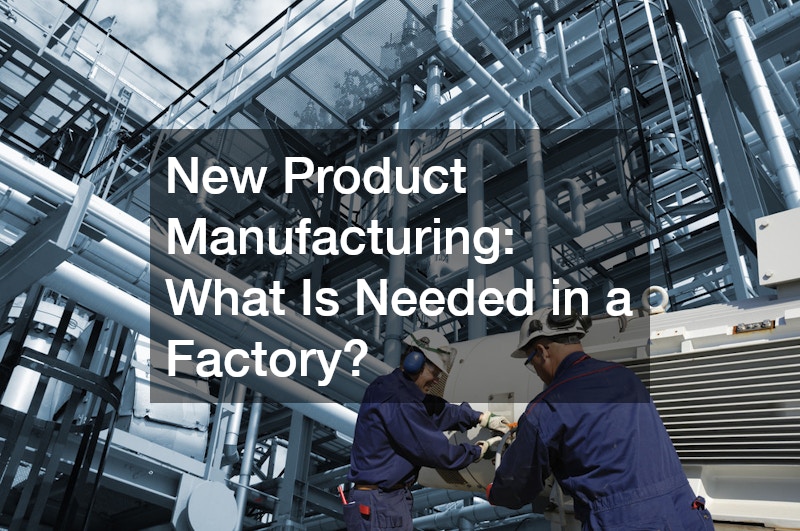Understanding the essentials of new product manufacturing is crucial for setting up an efficient and successful manufacturing facility. As industries evolve and consumer demands shift, having a well-structured manufacturing process can be the difference between success and failure. This article delves into the various components, technologies, and strategies needed to establish a robust manufacturing process that not only meets current demands but is also poised for future challenges.
1. What Are the Basic Requirements for Setting Up a New Product Manufacturing Facility?
1.1 Site and Infrastructure
The foundation of any manufacturing facility begins with the right site and infrastructure. The location should provide easy access to suppliers and logistics service providers to ensure seamless transportation of materials. Additionally, the infrastructure must be capable of supporting heavy equipment services, which are vital for tasks such as loading, unloading, and assembly of large components.
1.2 Essential Equipment
A manufacturing facility requires various types of equipment, depending on the products being manufactured. For instance, metal fabrication tools are crucial for shaping metal components, while precision machining equipment ensures that parts meet exact specifications. Incorporating machinery for custom metal fabrication allows for tailored solutions that meet unique client needs. A well-maintained maintenance plan is essential to keep all machinery operational and minimize downtime.
1.3 Skilled Workforce
A skilled workforce is perhaps the most critical component of a manufacturing operation. Workers must be trained in specific processes such as metal fabrication, operation of machinery, and adherence to safety protocols with technology like an access control installation. Continuous training programs will help ensure that employees are up to date with the latest manufacturing techniques and technologies, ultimately enhancing productivity.
2. How to Design an Efficient Production Line for New Products?
2.1 Process Flow Optimization
Designing an efficient production line involves optimizing the process flow. This includes arranging workstations in a manner that minimizes movement and delays, which can be achieved through techniques such as value stream mapping. By analyzing the flow of materials and information, manufacturers can identify bottlenecks and streamline operations.
2.2 Utilization of Automation
Incorporating automation into the production line can significantly enhance efficiency. Technologies such as robotic arms can take over repetitive tasks, reducing the risk of human error and increasing output. Additionally, using equipment like boom lift rentals can aid in reaching high areas for assembly and installation, enhancing worker safety and efficiency.
2.3 Quality Control Measures
Implementing robust quality control measures is vital for ensuring that products meet required specifications. Regular inspections, testing, and the use of precise measuring instruments are critical to maintaining quality during new product manufacturing. This also involves the integration of feedback loops that allow for continuous improvements in the production process.

3. What Technologies Are Key to Modern Manufacturing of New Products?
3.1 3D Printing and Additive Manufacturing
3D printing, or additive manufacturing, is revolutionizing the way products are developed. This technology allows for rapid prototyping and production of complex shapes that would be difficult to achieve with traditional methods. As a result, manufacturers can respond quickly to changes in consumer preferences and reduce lead times significantly.
3.2 IoT and Smart Manufacturing
The Internet of Things (IoT) has become a cornerstone of smart manufacturing. Sensors embedded in machinery can provide real-time data on performance, allowing for predictive maintenance. This reduces the likelihood of unexpected breakdowns and ensures that operations are continuously optimized.
3.3 Robotics and AI Integration
Integrating robotics and artificial intelligence into manufacturing processes enhances precision and efficiency. AI algorithms can analyze production data to predict maintenance needs, while robots can perform tasks such as assembly, working with a cogged vbelt, and packaging with high accuracy. This combination leads to improved productivity and lower operational costs during new product manufacturing.
4. How to Ensure Product Quality and Consistency?
4.1 Implementing Quality Management Systems
Quality management systems (QMS) provide a structured approach to managing quality across all processes. A QMS helps ensure that every aspect of manufacturing adheres to predefined standards, ultimately leading to improved product quality and consistency.
4.2 Regular Product Testing
Regular testing of products at various stages of production is essential to maintain quality. This includes material testing, component inspection, and final product evaluations. By identifying issues early, manufacturers can make necessary adjustments before products reach the market.
4.3 Supplier Quality Assurance
Collaboration with suppliers is critical for maintaining product quality. Establishing clear quality assurance protocols with logistics service providers and material suppliers helps ensure that the raw materials used in manufacturing meet necessary standards. This proactive approach minimizes the risk of defects and inconsistencies in the final product.
5. What Role Does Sustainability Play in New Product Manufacturing?
5.1 Sustainable Materials Usage
Sustainability is increasingly important in product manufacturing. Using sustainable materials not only meets consumer demand for eco-friendly products but can also reduce waste and lower production costs. Manufacturers should seek suppliers that offer recycled or sustainably sourced materials.
5.2 Energy-Efficient Operations
Implementing energy-efficient practices is vital for reducing the carbon footprint of manufacturing operations. This includes using energy-efficient machinery, optimizing energy usage, and exploring renewable energy options. Such initiatives not only benefit the environment but can also lead to significant cost savings.
5.3 Waste Management and Recycling
An effective waste management strategy is essential for minimizing environmental impact. This involves not only recycling materials but also finding innovative ways to reduce waste generation in the first place. Strategies such as reusing scrap metal in custom metal fabrication processes can contribute to a circular economy.

6. How to Plan for the Scalability of Manufacturing Processes?
6.1 Flexible Manufacturing Systems
Flexible manufacturing systems allow for quick adaptation to changing production needs. By utilizing modular machinery and equipment, manufacturers can easily scale operations up or down as required. This flexibility is crucial for meeting fluctuating consumer demands without incurring excessive costs.
6.2 Modular Production Lines
Modular production lines enable manufacturers to add or remove sections based on production needs. This adaptability ensures that manufacturers can respond swiftly to market changes, facilitating the introduction of new products or the scaling of existing ones.
6.3 Strategic Supply Chain Partnerships
Building strategic partnerships with logistics service providers and other suppliers enhances scalability. These partnerships can provide the necessary resources and support for expanding operations, ensuring that manufacturers can keep pace with demand while maintaining quality and efficiency.
7. How Do Regulations Impact New Product Manufacturing?
7.1 Compliance with Local and International Standards
Manufacturers must navigate a complex landscape of regulations, both local and international. Compliance with these standards is essential for ensuring product safety and quality. Failure to adhere can result in significant legal repercussions and damage to a company’s reputation.
7.2 Environmental and Safety Regulations
Environmental and safety regulations are particularly stringent in manufacturing. Companies must ensure that their operations do not harm the environment and that workers are protected from hazards. Regular audits and assessments are necessary to ensure compliance with these regulations.
7.3 Patent and Intellectual Property Considerations
Navigating patents and intellectual property rights is critical for manufacturers developing new products. Understanding these regulations helps protect innovations and prevents costly legal disputes. Businesses should work closely with legal experts to ensure their products do not infringe on existing patents.
8. What Are the Costs Associated with Manufacturing New Products?
8.1 Initial Setup Costs
The initial setup costs of a manufacturing facility can be significant. Expenses include site acquisition, infrastructure development, and the purchase of essential equipment such as metal fabrication tools and precision machining machines. It’s essential to create a detailed budget to ensure that all aspects of setup are accounted for.
8.2 Operational Expenses
Operational expenses encompass ongoing costs associated with running a manufacturing facility. This includes labor, maintenance, raw materials, and utilities. Implementing a comprehensive maintenance plan helps manage these costs by preventing unexpected breakdowns and prolonging the lifespan of equipment.
8.3 Cost-Control Strategies
To maintain profitability, manufacturers must implement effective cost-control strategies. This could involve negotiating better terms with suppliers, optimizing production processes, and reducing waste. By keeping a close eye on expenditures, businesses can improve their bottom line while continuing to innovate.

9. How to Implement Lean Manufacturing Techniques in New Product Development?
9.1 Streamlining Production Processes
Lean manufacturing techniques focus on eliminating waste and improving efficiency. By analyzing every step in the production process, manufacturers can identify non-value-adding activities and streamline operations. This not only reduces costs but also enhances product quality.
9.2 Reducing Waste and Inefficiencies
Waste reduction is a key principle of lean manufacturing. This can involve minimizing material waste through better inventory management or optimizing machine usage to ensure that every piece of equipment is utilized effectively. Techniques such as just-in-time inventory management can help achieve this goal.
9.3 Continuous Improvement Practices
Fostering a culture of continuous improvement is essential for long-term success. Encouraging employees to identify inefficiencies and suggest improvements can lead to significant enhancements in manufacturing processes. Regular training and workshops can help instill this mindset across the organization.
10. What Are the Trends in the Future of New Product Manufacturing?
10.1 Digital Twins and Virtual Manufacturing
The use of digital twins—virtual replicas of physical systems—allows manufacturers to simulate and optimize processes before implementation. This technology enhances decision-making and minimizes risks associated with new product development.
10.2 Green Technologies and Practices
As environmental concerns grow, the adoption of green technologies in manufacturing will become increasingly important. Companies that invest in sustainable practices will not only meet regulatory requirements but also attract environmentally conscious consumers.
10.3 Personalized and Custom Manufacturing
The demand for personalized products is on the rise. Manufacturers must adapt by embracing custom manufacturing techniques, such as those found in custom metal fabrication, to offer tailored solutions that meet individual customer preferences.
11. How to Leverage Data Analytics in Manufacturing Processes?
11.1 Data-Driven Decision Making
In today’s new product manufacturing landscape, data analytics plays a crucial role in optimizing operations. By leveraging data collected from various sources—such as machinery sensors, production logs, and supply chain metrics—manufacturers can gain valuable insights into their processes. This data-driven decision-making enables businesses to identify trends, predict failures, and make informed choices about resource allocation.
11.2 Predictive Maintenance
One of the key applications of data analytics in manufacturing is predictive maintenance. By analyzing equipment performance data, manufacturers can predict when machinery is likely to fail or require maintenance. This proactive approach helps minimize downtime, reduces repair costs, and extends the lifespan of equipment like precision machining tools and metal fabrication machines.
11.3 Performance Metrics and KPIs
Establishing clear performance metrics and key performance indicators (KPIs) allows manufacturers to track progress and measure success. Metrics such as production efficiency, scrap rates, and overall equipment effectiveness (OEE) provide a comprehensive view of operational performance. By continuously monitoring these metrics, manufacturers can identify areas for improvement and implement strategies to enhance productivity.

12. The Importance of Supply Chain Management in Manufacturing
12.1 Building Strong Supplier Relationships
Effective supply chain management is vital for ensuring a steady flow of materials and resources needed for manufacturing. Building strong relationships with logistics service providers and suppliers fosters collaboration, improves communication, and can lead to better pricing and availability of essential materials, such as coil springs and metal components.
12.2 Risk Management and Resilience
A well-managed supply chain helps mitigate risks associated with disruptions, whether from natural disasters, political issues, or economic fluctuations. By diversifying suppliers and maintaining safety stock, manufacturers can enhance their resilience against unforeseen challenges. Developing a robust contingency plan is essential for maintaining operations during crises.
12.3 Technology Integration in Supply Chain Management
The integration of technology in supply chain management can streamline operations and improve efficiency. Implementing software solutions for inventory management, order tracking, and supplier collaboration helps manufacturers optimize their supply chains. Moreover, technologies like IoT can provide real-time data on inventory levels, enabling better forecasting and decision-making.
13. The Role of Innovation in New Product Manufacturing
13.1 Embracing Research and Development
Continuous innovation is critical for staying competitive in the manufacturing sector. Investing in research and development (R&D) enables companies to explore new materials, processes, and technologies. This commitment to innovation can lead to breakthroughs in product design, efficiency, and sustainability.
13.2 Collaborative Innovation
Collaborative innovation involves partnering with other companies, research institutions, and industry experts to drive advancements in manufacturing. Such collaborations can lead to the development of cutting-edge technologies and practices, ultimately benefiting all parties involved. For instance, partnerships with technology firms can enhance capabilities in automation and smart manufacturing.
13.3 Intellectual Property and Competitive Advantage
Protecting innovations through patents and trademarks is essential for maintaining a competitive edge. Intellectual property rights safeguard the unique aspects of new products and processes, allowing manufacturers to capitalize on their innovations. By strategically managing their intellectual property, companies can create barriers to entry for competitors and secure their market position.
These additional sections provide deeper insights into crucial aspects of new product manufacturing, emphasizing the importance of data analytics, supply chain management, and innovation in maintaining a competitive edge in the industry.
Conclusion
The landscape of new product manufacturing is rapidly evolving with advancements in technology and changes in consumer demands. By understanding the essential components and strategies outlined in this article, businesses can successfully navigate this complex domain. Embracing innovation, focusing on quality, and prioritizing sustainability will position manufacturers for success in an increasingly competitive environment. With the right strategies in place, companies can not only meet current market demands but also thrive in the future.
